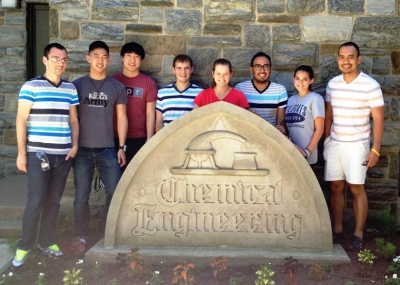Undergraduates Spend the Summer with Biomass Materials

Nicholas Fonzo ’16, Royce Lee ’17, Matthew Pak ’17, Charles Ponge ’16, graduate student Nicole Hammer, Rene Garrido PhD ’14, Emily Woloshen ’17 and Justinus Satrio, PhD, Assistant Professor, Chemical Engineering
By Anira Jones
While many college students enjoyed downtime over the summer, eight Villanova University undergraduates kept busy in White Hall, home of the Chemical Engineering department. Juniors Julie Clarke, Nicholas Fonzo, Charles Ponge and Anthony Vallace, sophomores Royce Lee, Matthew Pak and Emily Woloshen, and senior Joshua Rickert spent 20-35 hours a week in the Biomass Resources and Conversion Technologies Laboratory (BRCT), where the goal is to develop technologies for converting biomass—plant- and animal-derived materials—to produce energy, chemical products and fuels.
BRCT research has become increasingly important as the country seeks to reduce its reliance on environmentally harmful fossil fuels, and to replace them with healthier alternatives. Under the leadership of Lab Director and Assistant Professor of Chemical Engineering, Dr. Justinus Satrio, participating students have gained skills and knowledge performing research in biomass characterization, conversion processes, and catalyst development, which are parts of the research scope of the BRCT laboratory.
With the help of graduate students serving as mentors, undergraduates used different types of reactor systems to evaluate a variety of biomass materials, such as algae, switchgrass, phragmites, pinewood and horse manure, to determine their potential value as feedstock for fuel production. The primary conversion process that the BRCT laboratory focuses on is fast pyrolysis, which involves decomposing biomass to produce a liquid (bio-oil), a solid (bio-char) and a non-condensable gas stream (synthesis gas) by exposing the material to heat at high temperature in the absence of oxygen.
Some of the students who worked in the BRCT lab were volunteers, while others received funding through the Chemical Engineering Department, external research sources, or the Villanova Undergraduate Research Fellowship program. A significant portion of the students’ research activities were part of an on-going federally-supported research project titled “Distributed On-Farm Bioenergy, Biofuels and Biochemicals (FarmBio3) Development and Production via Integrated Catalytic Thermolysis.” For this project, Villanova University is part of a consortium of 14 institutions organized by USDA Agricultural Research Services in Wyndmoor, Pa. Leading the Villanova research with Dr. Satrio is Dr. Charles Coe, associate research professor of Chemical Engineering.
The students working on the biomass projects were surprised that their time was not spent solely on reading and note-taking, but on actual hands-on research using equipment to attempt to solve real-world problems. Dr. Satrio explains why he is such a strong proponent of engaging undergraduate students of all levels in the laboratory: “Students acquire invaluable skills by performing research. Learning how to correctly use laboratory instruments, improving their analytical skills, developing the ability to think independently, and working as part of a team are vital for students’ success beyond the classroom.” He adds, “They look great to future employers, too!” Ultimately, Dr. Satrio’s goal in offering these summer projects is “for students to love research and gain knowledge and skills for their future careers.”
